Humans and Dolphins
Air Date: Week of October 2, 2015
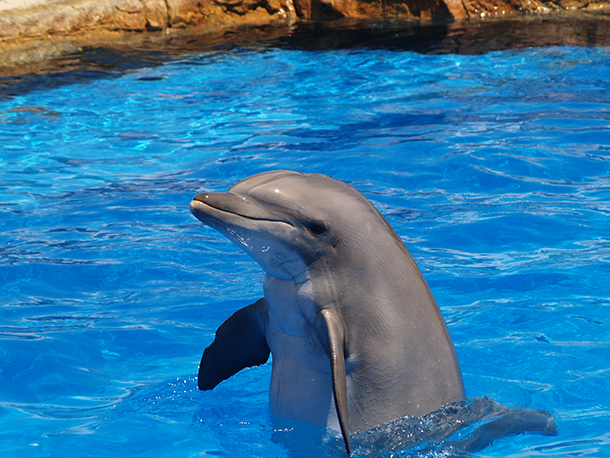
A dolphin has a brain that’s about 20% bigger than a human’s -- though, proportional to body mass, a dolphin brain is less than half as big as a human’s. (Photo: Bryce Bradford, Flickr CC BY-NC-ND 2.0)
Dolphins have fascinated humans for thousands of years, inspiring art, scientific study, and a yearning to keep them close. They’re the subject of Susan Casey’s new book ‘Voices in the Ocean’,and she discusses with host Steve Curwood what’s remarkable and troubling about the ways we sometimes interact with and affect dolphin species.
Transcript
CURWOOD: It’s Living on Earth, I'm Steve Curwood. Humans and dolphins have a long connection. Myth and literature abound with tales of dolphins rescuing hapless sailors and travelers washed overboard. And after Apollo hitched a ride on one round the south of Greece, they gave their name to his temple at Delphi. Dolphins routinely keep company with boats, they’ve been conscripted by the military, they’re held captive to perform in animal parks, and they’ve found a role in animal-assisted therapy. And writer Susan Casey set off on a quest that led to her new book, Voices in the Ocean: A Journey into the Wild and Haunting World of Dolphins, after a swim with them in the waters off Hawaii changed her life.
CASEY: You know, I was in a sort of grief-stricken depressed state of my life because I had lost my father suddenly, and I hadn’t been able to shake that sadness, and it was very interesting to me that after I had this swim with the wild dolphins of the coast of Maui something had lifted in me, there was like the sense of curiosity and joy crept back into my life and that was what I have been missing for almost 2 years. So then I started looking and that's when I realized just how much amazing science there was, how many amazing stories. This dolphin being used by treasure hunters to help them locate undersea treasure, the stories of dolphins being recruited by the U.S. Navy to serve as soldiers, and dolphins saving surfers from shark attacks, and it just went from there.
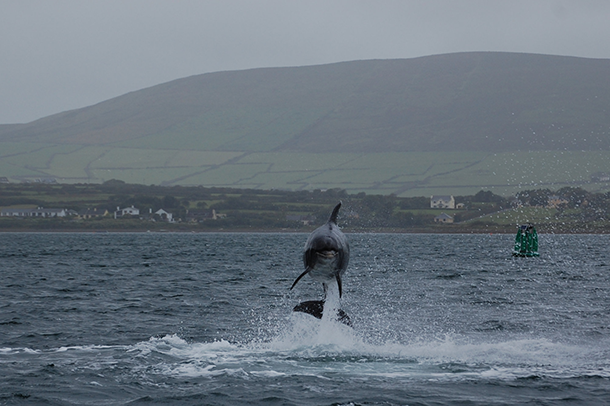
Fungie, a wild bottlenose dolphin who has made himself the centerpiece of the tourism industry in the town of Dingle, Ireland, has been named the “World’s Most Loyal Animal.” (Photo: Dulup, Flickr CC BY-SA 2.0)
CURWOOD: Well, let’s talk a little about the science of dolphins for a moment. What's really unusual about them as physical creatures?
CASEY: Well, one of the things that’s highly unusual about them is their evolutionary path. I mean, these are animals that began on land as a small-hoofed wolf, and that animal then went into the water around 55 million years ago and became a large sort of monstrous creature with big teeth and not a very big brain, and then around 35 million years ago there was another radical physiological change. They became smaller, they developed high-frequency hearing, their brains became much larger, they started to hunt cooperatively, and they became more or less the dolphins that we know today. So dolphins have done this incredible shape shifting, and along the way their brains have developed two hemispheres just like ours, but with completely different wiring. We arrived at the same spot, we’re both air-breathing mammals with large brains and high intelligence, but along completely different itineraries. And, to me, that was one of the most fascinating parts of the research, was how is the dolphin brain different than the human brain, what does that possibly mean about their abilities or cognition their social structures, and, you know, there's more than one way to be smart here on planet Earth and theirs is much more ancient than ours.
CURWOOD: Tell me about dolphin culture and society, and there’s a part of your book where you describe the different tribes, families, whatever, of Orcas that can be found off Seattle.
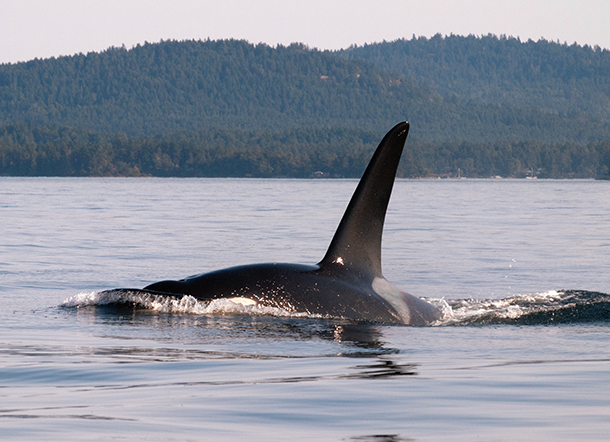
Orca in Puget Sound, near San Juan Island. (Photo: Ingrid Taylar, Flickr CC BY 2.0)
CASEY: Yeah, one of the most intriguing new directions for science about dolphins is that several scientists have come up with enough evidence that they feel confident saying that these dolphins live in societies and cultures that are not unlike ours. They are, of course, very different, but they have communities, they have families they learn socially like we do, so it fits the definition of cultural information being exchanged down through the generations. And these pods have their own dialects; scientists think that may be to protect against inbreeding, but it's clear that these animals have very distinct cultures throughout the world’s oceans.
CURWOOD: Alright, so tell me about the different ethnicities of orcas off Seattle.
CASEY: There're three different kinds of Orcas off the coast of Seattle. Scientists call them residents, transients and offshores and these three types of Orcas have about as much in common as investment bankers, rock stars, and nomadic herdsmen. The residents are the ones you see closer to shore. They hunt salmon, they have been seen in the company of transients, but the two types of Orcas don't really socialize, and at times there'll be scuffles. But when the residents meet other resident clans, occasionally they have this greeting ceremony that they do that’s very ritualized where the two pods will line up and face each other for a while, and then there's a lot of vocalization, a lot of contact, a lot of exuberant socializing, and they have these rituals sort of akin to the cultures that we have. The transients hunt marine mammals, seals and larger creatures like that, and then the offshore Orcas, which are the least known of those three types, seem to hunt sharks. So these three different cultures live in close proximity to one another but they don't have a lot to do with each other, and they have sort of split up their niche so that they're not at any one point depleting the food supply.
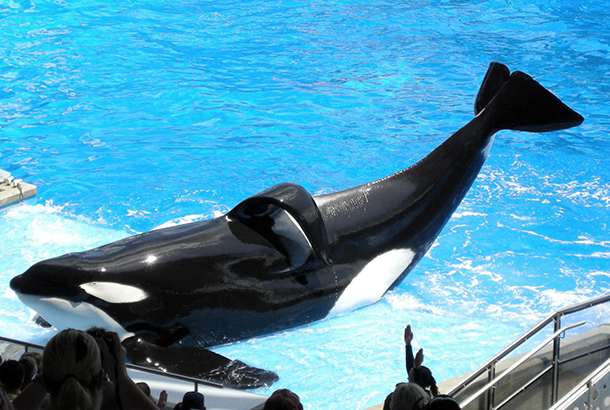
Casey says that while certain dolphin species are more adaptable to human interaction, orcas do poorly around people. (Photo: Milan Boers, Flickr CC BY 2.0)
CURWOOD: You write about John Lilly, a dolphin researcher whose studies became controversial. Tell me about him and some of his experiments.
CASEY: Well, I feel like I could write an entire book on John Lilly. He was a neuroscientist in the 50s and 60s, and he was very interested in knowing how the brain was structured, and, theoretically, if I could figure that out, if I could I poke a wire on this part of your brain and get you to do something accordingly. It's a really simplistic notion of how the brain works, but he happened to see a dolphin brain and just realized, like, here’s a big brain. He started work with bottlenose dolphins and was absolutely enraptured by the notion of this animal, and made these wild leaps into realms like, “well, they can communicate, so we could probably teach them to speak English, let's go do that” and in a sort of wonderfully audacious way got a bunch of money from various government agencies, got some land in the US Virgin Islands and created this sort of Xanadu of dolphin studies. And I love looking at pictures of it because you see Lilly standing there in this lab coat and there are the dolphins in these Mediterranean-style laboratory buildings and then there're always about 10 beautiful young women in bikinis, like it was this sort of Dr. No Dolphin Island. But things went from a little bit odd to quite bizarre rather quickly. Lilly began several experiments that would later be known as among some of the most ill-advised ever conducted in science.
CURWOOD: What kinds of things did he do - I gather at one point he had a woman living with a dolphin?
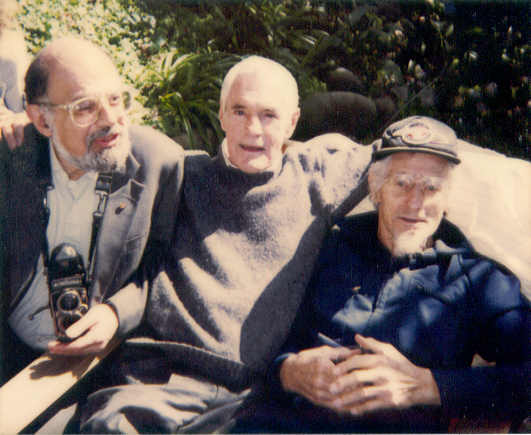
From left: Allen Ginsberg, Timothy Leary, and controversial dolphin researcher John C. Lilly, M.D. (Photo: Philip H. Bailey, Flickr CC BY-SA 2.5)
CASEY: Yeah I mean I think that's number one on the list of notorious experiments. The woman's name was Margaret Howe; she was a local woman from the US Virgin Islands and Lily wanted to see what would happen if you put a young dolphin in with a sort of a mother figure, a young female adult human, and flooded a house with twenty four inches of saltwater. Theoretically, the dolphin could swim in that and Margaret could slosh around in there. So they set out to live for 10 weeks in this house, the idea being that she would teach the dolphin how to speak English the same way that we teach our own children to speak English. But things went sideways very quickly. The dolphin was able to make noises and certainly mimic, but Margaret was coming apart because she could never get dry. She was around the clock with him, and he, to put it euphemistically, did not see her in a kind of parental role, he really saw her as a paramour and dolphins are highly sexualized. He began to follow her around making his desires very clear. And eventually Margaret decided that, well, the idea is to strengthen an interspecies bond here, let’s go for it. And she began to pleasure the dolphin, and I think at that point, when they published notes of that experiment, that’s when mainstream science really wrote Lilly off.
CURWOOD: It sounds pretty crazy.
CASEY: Yeah.
CURWOOD: How much sense does it make to confine dolphins and their relations in marine parks?
CASEY: Well,what you’re looking at in a marine park is a dolphin stripped of everything that makes him a dolphin—who’s not using his echolocation, who’s not with his closest compatriots, who’s not able to swim 60 or 70 miles a day in the ocean, who’s not hunting fish, he’s being served dead fish—and we know that they’re individuals. And we know they’re conscious of their surroundings, so what do we do with that knowledge? And that would be my question to anyone who feels, hey let’s go to a marine park, you know — knowing what you know, how do you defend doing that to a dolphin?
CURWOOD: Now, in Ireland there’s essentially a dolphin park where a dolphin entertains visitors except this particular dolphin is free to come and go. Tell me about him.
CASEY: Well, this is Fungie. Fungie lives in a bay in Dingle, Ireland. Fungie is famous. He’s been there for about 38 years. He was named the world’s most loyal animal. He basically is there all the time. The economy of the town completely depends on Fungie. About 5000 people a day come in the summer to see him and go out in the bay and it’s literally your money back if you don’t see him. He isn’t fed, he isn’t coerced in anyway to be there. And I was a little skeptical about this because I had heard about him but he seemed a little too good to be true, and I was wondering if he was the concoction of the Chamber of Commerce or something like that. And whether he was in some way trained or fed or maybe there was more than one dolphin and they were all Fungie, the same way there were a lot of Lassies. But I got there and almost immediately saw him and realized how distinctive he looks and how there’s absolutely no way they could ever swap in another dolphin. And so it was really curious to me, why does this particular dolphin choose to interact with humans, but as it happens he’s not completely unique. All over the world certain animals will break off from their groups and interact with humans, and scientists don’t know why this happens. They think maybe the dolphin at some point got lost and just decided to bond with humans. But usually this kind of relationship doesn’t end well for the dolphin because people end up coming far to close and in great numbers and it’s typical for them to get hit by propellers or jetskis. And Fungie’s more the exception than the rule, having lasted so long and being so well protected by the town.
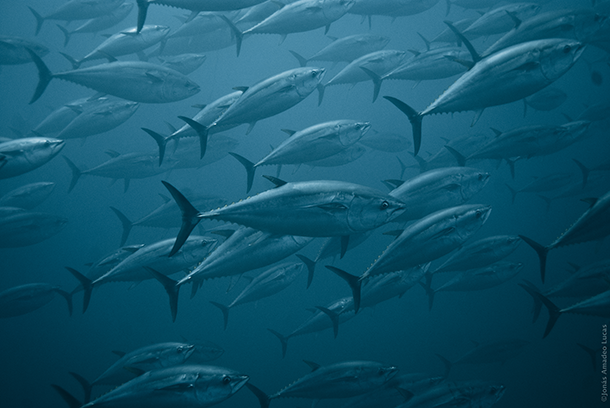
Where tuna are, dolphins often follow. This can end badly for the dolphins if they’re caught in fishing nets along with the tuna; but good fishing practices allow dolphins to swim free of the net. (Photo: TheAnimalDay.org, Flickr CC BY 2.0)
CURWOOD: Susan, how do you respond to the argument made by aquatic zoos, I’m thinking of SeaWorld, that giving public exposure to these animals helps to protect them over the long run.
CASEY: I mean I think that one of the scientists that I interviewed, Robin Baird, an amazing scientist, believes that seeing animals in aquariums and zoos really sparked his career choice, so I believe there is a value to that. But I think we can create environments that serve that function in a much better way if the intention really was education, as opposed to entertainment with a little bit of education thrown in. In Honduras, for example, there’s a place where some Bottlenosed Dolphins are given a little bit of food, but they’re not captives. They’ve chosen to be there in the same way as Fungie is. So I would like to see the conservation messages get real, the education messages get very science based. I look at the Monterey Bay Aquarium and they are just such a fabulous aquarium based on cutting edge science. There are no dolphins doing tail walking tricks and stuff like that, it’s not what its about. And then there are just some species that just don’t belong in captivity, Orcas are really at the top of that list.
CURWOOD: In your view how are we harming dolphins?
CASEY: Well, in several different ways they are up against it because of things we’re doing in the ocean. We’re overfishing in destructive ways that don’t allow for fish stocks to rebound or any sort of sustainable harvest of fish, so dolphins eat the same fish we do, and a lot of dolphins will end up tangled in long lines or with fishing hooks in their throats. And then of course you have the tuna fishing industry, which for the longest time was killing tremendous amounts of dolphins. Now we’re aware of that and Earth Island Institute has its dolphin-safe program globally which has helped. And then obviously the oceans are highly polluted. They are at the top of the food chain, they bioaccumulate things like mercury, other toxins, long-lived pollutants that still circulate in the oceans like PCBs, and dioxins, stuff we outlawed but its still there. And then the other problem is the noise in the oceans. The military sonar, which is incredibly loud. The prospecting for oil and gas that uses these airguns that literally explode underwater. All these things can deafen and even kill dolphins.

Susan Casey is also the author of the New York Times bestsellers The Wave and The Devil’s Teeth. (Photo: courtesy of Doubleday)
CURWOOD: From your own experience, your favorite dolphin?
CASEY: I think I became enchanted with false killer whales even though I haven’t seen them in the wild just from hearing this scientist Robin Baird talk about them. They are one of the largest species of dolphins. They are very engaged and engaging. They seem to be particularly curious about humans. They have a ritualized way of hunting where when they catch a fish they pass it around amongst each other and nobody takes a bite. So there’s a lot of intriguing things about false killer whales. Seeing one in the wild would be at the top of my list.
CURWOOD: Susan Casey is the author of Voices in the Ocean, and the New York Times bestsellers the Wave and the Devil’s Teeth. Susan thanks so much for taking the time today.
CASEY: Thank you.
Links
NOAA Fisheries’ Protect Dolphins Campaign
Pacific Northwest Orcas: distinct populations
The dolphin who loved me: the NASA-funded project that went wrong
Living on Earth wants to hear from you!
Living on Earth
62 Calef Highway, Suite 212
Lee, NH 03861
Telephone: 617-287-4121
E-mail: comments@loe.org
Newsletter [Click here]
Donate to Living on Earth!
Living on Earth is an independent media program and relies entirely on contributions from listeners and institutions supporting public service. Please donate now to preserve an independent environmental voice.
NewsletterLiving on Earth offers a weekly delivery of the show's rundown to your mailbox. Sign up for our newsletter today!
 Sailors For The Sea: Be the change you want to sea.
Sailors For The Sea: Be the change you want to sea.
 The Grantham Foundation for the Protection of the Environment: Committed to protecting and improving the health of the global environment.
The Grantham Foundation for the Protection of the Environment: Committed to protecting and improving the health of the global environment.
 Contribute to Living on Earth and receive, as our gift to you, an archival print of one of Mark Seth Lender's extraordinary wildlife photographs. Follow the link to see Mark's current collection of photographs.
Contribute to Living on Earth and receive, as our gift to you, an archival print of one of Mark Seth Lender's extraordinary wildlife photographs. Follow the link to see Mark's current collection of photographs.
 Buy a signed copy of Mark Seth Lender's book Smeagull the Seagull & support Living on Earth
Buy a signed copy of Mark Seth Lender's book Smeagull the Seagull & support Living on Earth

